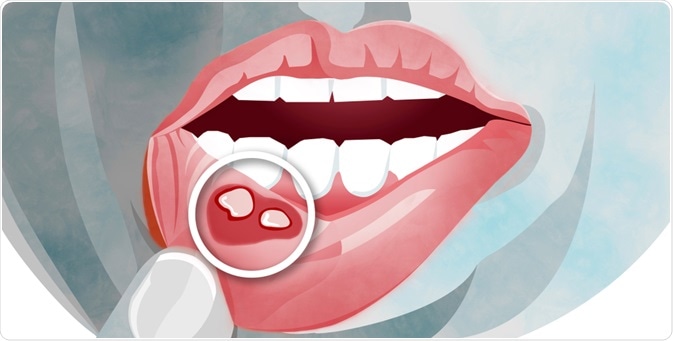Stomatitis refers to inflammation of the mouth, and causes a red and swollen appearance of the mouth, with pain, or as discrete ulcers.

Naeblys | Shutterstock
Rarely, no ulcers develop, and only a burning sensation inside the mouth occurs. Stomatitis can involve any part of the mouth, including the cheeks, gums, tongue, throat, lips and roof or floor.
Aphthous ulcers are the most common cause of stomatitis. These ulcers are acute, painful ulcers on the tongue, or the inside of the lips or cheeks. They are also called canker sores, and have a reddish base, with a yellowish covering.
Aphthous ulcers are not associated with other symptoms and heal in one to two weeks. They usually appear first after the age of 10 years and may reappear on and off over the next few years.
Types of recurrent aphthous stomatitis
Minor recurrent aphthous stomatitis
This is the most common type, appearing on the lips, cheeks and tongue. Typically, they leave no scar once healed.
Major recurrent aphthous stomatitis
This type is characterized by large ulcers that last from two to six weeks. They can appear anywhere in the mouth, including the gums, the roof of the mouth, and the throat.
Herpetiform recurrent aphthous stomatitis
These ulcers are tiny, and very painful. A high number, around twenty to thirty, can appear at once and may join to form larger areas of ulceration.
What causes stomatitis?
Stomatitis has several possible causes, which may overlap or interact with each other.
Local causes of stomatitis include factors such as:
- Trauma: Trauma can possibly stem from ill-fitting dentures or other dental appliances like braces or retainers.
- Infections: Stomatitis can be caused by bacterial infections, such as syphilis, or viral infections, such as herpes simplex and herpes zoster. Ulcers can also be caused by hand, foot, and mouth disease (Coxsackie virus), or yeast infections.
- Other local causes include a weakened or deficient immune system, chemical irritation, and medications such as sulfonamide drugs, which treat conditions from eye infections to rheumatoid arthritis and include antibiotics, can also cause stomatitis, along with anti-epileptic drugs.
Systemic causes include:
- Stress
- Behçet’s disease (inflammation of the blood vessels and tissues)
- Celiac disease (inflammation of the small intestine)
- Lupus
- Other illnesses affecting the blood vessels
- Nutritional deficiencies, such as riboflavin deficiency
- Chemotherapy for cancer
- Allergic reactions
- Any condition which is associated with xerostomia (dry mouth)
- Sexually transmitted diseases such as syphilis, gonorrhea
- Other infections such as acute necrotizing ulcerative gingivitis.
Conditions associated with stomatitis
RAS, herpes simplex and Behçet’s disease can all cause recurrent oral ulcers. Yeast infection as a cause of stomatitis should be suspected in the presence of diabetes, HIV infection, or any other condition which causes weakened immunity.
Some diseases have symptoms associated with stomatitis, including:
- Gastrointestinal symptoms with celiac disease, or inflammatory bowel disease
- Skin bullae with pemphigus
- Fever, conjunctival redness and skin rashes with Steven-Johnson syndrome
- Erythema and palmar skin scaling with Kawasaki disease.
Conditions that present with both skin and oral ulceration include:
- Steven-Johnson syndrome (flu-like symptoms followed by a rash and blisters)
- Erythema multiforme (quick-spreading skin reaction)
- Pemphigus (rare and serious condition characterized by blisters on the skin, lining of the mouth, nose, throat and genitals)
- Bullous pemphigoid (blisters between the epidermis and dermis)
- Kawasaki disease (inflamed blood vessels)
- Hand, foot, and, mouth disease
- Varicella or herpes zoster (chickenpox and shingles)
- Secondary syphilis
Conditions that manifest with oral ulcers alone include:
- RAS
- Herpes simplex
- Behçet’s disease
- Yeast infections
- Acute necrotizing ulcerative gingivitis
- STDs such as primary syphilis and gonorrhea
- Most viral causes
How is stomatitis diagnosed?
Diagnosis depends on a careful history and examination. A lot of information can be obtained by carefully noting the type and distribution of the ulcers, their appearance, a history of sexual contact with multiple partners, the medications the patient is on or has taken in the past, a history of tobacco use, and information on other symptoms that may indicate the presence of systemic disease.
In the absence of systemic symptoms, a diagnosis of primary ulceration is easy, and no testing is required. If such symptoms are present, or ulcers persist without obvious cause, testing and sometimes, but not often, a biopsy should be carried out.
Treating stomatitis
Treatment includes eliminating or treating any obvious local or systemic causes, good oral hygiene, salt-water rinses, use of a soft toothbrush, and the use of mouthwashes that, preferably, do not contain alcohol.
Topical treatments include the use of anesthetics, substances that coat the ulcer, steroids, or cauterization. Painkillers can be prescribed to reduce the amount of discomfort stomatitis can cause, which can help with brushing teeth.
If stomatitis is left untreated, it will continue to worsen. To prevent spreading mouth sores that are contagious, avoiding kissing, sharing cups or cutlery with other people is recommended.
Is stomatitis preventable?
Some vitamins can help prevent the development of stomatitis. B vitamins can be beneficial. Foods containing high levels of vitamin B include:
- Broccoli
- Bell peppers
- Spinach
- Beetroot
- Calf Liver
- Lentils
- Asparagus
Further Reading
Last Updated: Feb 27, 2019